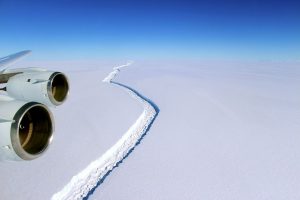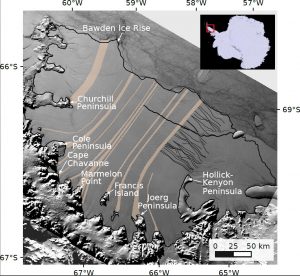8 May 2017
Bands of extra-tough ice slow down cracks in Antarctica’s Larsen C ice shelf
Posted by Nanci Bompey
By Lauren Lipuma

The rift in Antarctica’s Larsen C measures about 100 meters (300 feet) wide and cuts about half a kilometer (one-third of a mile) deep — completely through to the bottom of the ice shelf. New research shows bands of extra-tough ice stabilized the crack for decades.
Credit: NASA/John Sonntag.
The stability of the Antarctic Peninsula’s largest ice shelf may depend upon stripes of extremely strong ice running down its spine, a new study finds.
New research shows rifts in the Larsen C ice shelf tend to stop when they hit parts of the ice known as suture zones. Suture zones are bands of ice several kilometers wide running from the grounding line out to sea that are made of ice from different glaciers and sea water that have frozen together.
The new study finds the large crack currently winding its way across Larsen C takes much longer to punch through suture zones than through other types of ice, meaning these zones are far more important in holding ice shelves together than previously thought, according to the authors.
“There’s something about that combination of different kinds of ice that’s particularly good at stopping these cracks,” said Chris Borstad, a glaciologist at the University Centre in Svalbard, Norway, and lead author of the new study in Geophysical Research Letters, a journal of the American Geophysical Union. “What we’re seeing with this current crack is every time it’s encountered one of these suture zones, it pauses briefly, and needs a little extra time or force to pop through it.”
The new finding questions existing theories of ice shelf stability, according to the authors. By better understanding suture zones and how the current rift acts when it meets them, scientists can better predict how ice shelves are glued together and how they will respond to a changing climate, Borstad said.
Watching a crack in the ice
Ice shelves, the parts of glaciers and ice sheets that extend over the open ocean, act as buttresses for ice that rests on solid ground. Much like corks in a bottle, ice shelves block the grounded ice behind them from flowing into the sea.
Antarctica’s Larsen C ice shelf is roughly the size of Lake Michigan. Rifts are common and natural features on ice shelves, but in 2014, one rift in Larsen C crossed through a suture zone that had previously kept it stable. This crack and many others on Larsen C started out in the southernmost part of the ice shelf and grew toward the northwest, parallel to the grounding line. In December 2016 alone, the rift grew nearly 18 kilometers (11 miles) and it has now grown by nearly 100 kilometers (60 miles) since 2014.
When the rift reaches the other side of the ice, an iceberg the size of Delaware will break off from the shelf. Scientists worry the crack could destabilize the entire ice shelf when this happens, allowing ice behind it to flow into the sea and raise sea levels.

This image shows Larsen C and its suture zones that run southwest to northeast (tan stripes) from the grounding line to the ocean. Many prominent cracks originating in the southernmost part of the ice shelf (black lines) have been stopped by the Joerg Peninsula suture zone for decades. But it 2014, one crack popped through and has continued to propagate across the ice shelf.
Credit: Geophysical Research Letters/AGU/Chris Borstad.
In the new study, Borstad and his colleagues looked at satellite observations of the crack over time to better understand why it’s been growing so quickly and what its growth might mean for the ice shelf’s stability. They then plugged the satellite data into a model of the ice shelf to see where the crack may end up and what that might mean for the ice shelf’s future.
They found suture zones in Larsen C have significantly slowed down the growth of the current rift. The suture zones run perpendicular to the growing cracks, stopping them in their tracks. Much like steel rods reinforce concrete, these suture zones appear to reinforce the ice shelf.
They also found the ice shelf’s southernmost suture zone had stopped dozens of cracks in Larsen C – including the current one – for decades. They found this suture zone kept the current crack at a nearly constant size from 2008 to 2014. They suspect that without this suture zone, Larsen C would likely not exist in its present form, if at all.
It is unclear which direction the current crack will continue moving and if it will hit additional suture zones that could impede its progress. But wherever the crack ends up, when it reaches the other side it will cause changes to the ice that would ripple all the way back to the grounding line, according to the study. The researchers found that if the crack continues in the northwesterly direction it’s moving now, it could hit an island the ice shelf is bumping into that’s helping to stabilize it. If that happens, the ice shelf will be in trouble, Borstad said.
“It’s closer to going toward the worst-case scenario end of our predictions,” he said. “So it’s possible there could be a problem here.”
— Lauren Lipuma is a public information specialist and writer at AGU. Follow her on twitter at @Tenacious_She.


 GeoSpace is a blog on Earth and space science, managed by AGU’s Public Information staff. The blog features posts by AGU writers and guest contributors on all sorts of relevant science topics, but with a focus on new research and geo and space sciences-related stories that are currently in the news.
GeoSpace is a blog on Earth and space science, managed by AGU’s Public Information staff. The blog features posts by AGU writers and guest contributors on all sorts of relevant science topics, but with a focus on new research and geo and space sciences-related stories that are currently in the news.